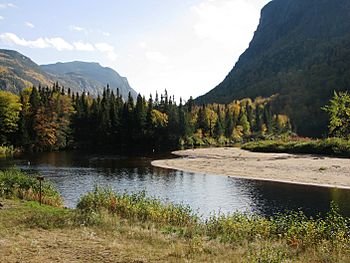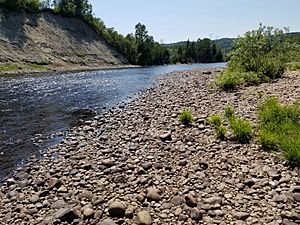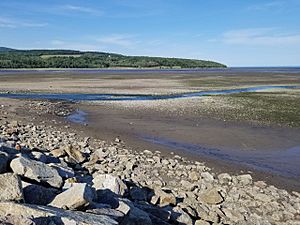Malbaie River facts for kids
Quick facts for kids Malbaie River |
|
|---|---|

Malbaie River in Hautes-Gorges-de-la-Rivière-Malbaie National Park
|
|
| Other name(s) | Rivière Malbaie (in French) |
| Country | Canada |
| Province | Quebec |
| Region | Capitale-Nationale |
| Physical characteristics | |
| Main source | Petit lac Tristan Lac-Jacques-Cartier (unorganized territory), Capitale-Nationale, Quebec, Canada 893 m (2,930 ft) 47°28′38″N 70°08′50″W / 47.47713°N 70.14722°W |
| River mouth | Saint Lawrence Estuary La Malbaie, Capitale-Nationale, Quebec, Canada 0 m (0 ft) 47°39′18″N 70°08′50″W / 47.65500°N 70.14722°W |
| Length | 161 km (100 mi) |
| Basin features | |
| Basin size | 2,059 km2 (795 sq mi) |
| Tributaries |
|
The Malbaie River is a beautiful river in the Charlevoix region of Quebec, Canada. It flows into the mighty Saint Lawrence River at a town called La Malbaie. For many years, until 1985, this river was like a highway for logs, helping to transport them downstream.
The river carves its way through a very steep valley known as Les Hautes Gorges. Here, you can find an old forest of sugar maples and American elms. This forest has been mostly untouched for hundreds of years, making it a special place.
The Malbaie River flows through several important protected areas. These include Grands-Jardins National Park, Laurentides Wildlife Reserve, Zec des Martres, Hautes-Gorges-de-la-Rivière-Malbaie National Park, and Zec du Lac-au-Sable. The river travels about 161 kilometers (100 miles) and drops 820 meters (2,690 feet) in height from its source to its mouth.
The river's path forms a big curve, almost like a semicircle. This curve goes north and wraps around the area where the Rivière du Gouffre flows. The land drained by the Malbaie River and the Rivière du Gouffre together form the Charlevoix Biosphere Reserve. This reserve is a special area recognized by UNESCO for its unique nature.
Contents
Exploring the Hautes-Gorges National Park
The Hautes-Gorges-de-la-Rivière-Malbaie National Park is famous for having some of the tallest rock cliffs in Eastern Canada. It became a national park in Quebec in the year 2000. This park covers a large area of 233 square kilometers (90 square miles). It is a central part of the UNESCO Charlevoix biosphere reserve, showing how important its natural beauty is.
Where the Malbaie River Begins
The Malbaie River starts from a small body of water called "Petit lac Tristan." This lake is found in a wet, swampy area nestled in a small mountain valley. From Petit lac Tristan, the water flows north through swamps to Tristan Lake, which is about 1.8 kilometers (1.1 miles) long.
The water then continues its journey north for about 3 kilometers (1.9 miles) to Gamache Lake. From Gamache Lake, the river flows north again for 1.4 kilometers (0.9 miles) before reaching the outlet of Lamfort Lake.
After this, the Malbaie River flows for about 5.7 kilometers (3.5 miles) to Fradette Lake. This lake is about 2.5 kilometers (1.6 miles) long and flows from south to north. Fradette Lake gets water from other lakes like Carroll, Milton, and Brunette. From Fradette Lake, the river flows northeast for 2.4 kilometers (1.5 miles) to Malbaie Lake. The Malbaie River then crosses Malbaie Lake for about 2.3 kilometers (1.4 miles).
The water leaves Malbaie Lake from its northern end.
The River's Journey Downstream
After Malbaie Lake, the river continues its long journey. It flows north for about 3.6 kilometers (2.2 miles), picking up water from other small lakes. Then, it turns east.
The river then flows northeast for 12 kilometers (7.5 miles), collecting water from Lac des Sixty-Six. It then turns north until it meets the Jardin River.
Next, the Malbaie River flows north for 6 kilometers (3.7 miles), receiving water from Lake Duberger, until it meets the L'Enfer River.
It continues north for 7.7 kilometers (4.8 miles), collecting water from Pigeon Lake. Then, it bends northeast until it meets the Petite rivière Malbaie, which flows in from the east.
The river flows north for another 6.1 kilometers (3.8 miles), bending northwest, until it meets the Chemin des Canots River.
For the next 9.1 kilometers (5.7 miles), the Malbaie River flows north, making some turns, until it meets the Barley River.
It continues north for another 9.1 kilometers (5.7 miles), collecting water from Cold stream and Cow's stream. It forms a loop and an S-shape before meeting the rivière à la Cruche.
Middle Part of the Malbaie River
After the Cruche River, the Malbaie River flows northeast for 0.7 kilometers (0.4 miles) until it meets the Porc-Épic River.
It then flows north for 6.8 kilometers (4.2 miles), making a big curve to the east.
Next, it flows northwest for 4.1 kilometers (2.5 miles), collecting water from the Cran Rouge stream.
It continues northeast for 3.4 kilometers (2.1 miles) to the Caribou stream.
The river then flows northeast for 6.2 kilometers (3.9 miles) to ruisseau à John (Malbaie River).
It flows east for 6.5 kilometers (4 miles) through a deep valley, collecting water from Lac Plat. It forms a loop to the south.
For 11.7 kilometers (7.3 miles), it flows east through a deep valley, passing some rapids. It collects water from the North stream and Scott stream.
Finally, it flows south for 5.7 kilometers (3.5 miles) through a section called "Les Eaux-Mortes" and a wider part of the river, until it meets the rivière des Martres.
The Lower Part of the Malbaie River
After the Martres River, the Malbaie River flows southeast for 2.1 kilometers (1.3 miles) to the Ruisseau des Érables.
It then flows east for 6.8 kilometers (4.2 miles) to the Larouche stream, then northeast to the Pont stream.
For 4.8 kilometers (3 miles), it flows east, then south, passing a mountain and collecting water from the Cold stream, until it meets the Foulon stream.
It flows south for 2.8 kilometers (1.7 miles), forming a loop to the west, until it meets the Rouillé stream.
For the next 6.4 kilometers (4 miles), it forms a hook towards the north, then east, southeast, and finally east, until it meets the brook of the Americans.
Final Stretch to the Saint Lawrence River
In its final stretch, the Malbaie River flows south for 4.6 kilometers (2.9 miles), making a big curve to the east. It collects water from the Beavers stream and the Pied des Monts stream.
It then flows southeast for 10.1 kilometers (6.3 miles), collecting water from Long Lake, then winding northeast until it meets the outlet of Lake Nairne.
For 4.3 kilometers (2.7 miles), it flows east, forming a big loop to the north, until it meets the Snigole River. This river flows into a dammed lake.
It flows east for 2.0 kilometers (1.2 miles), crossing a small dam, until it meets the Jacob River.
Finally, for 7.4 kilometers (4.6 miles), it flows east, making large loops through the town of La Malbaie, until it meets the Comporté River.
The Malbaie River then flows for another 2.5 kilometers (1.6 miles) eastward until it reaches its mouth. It empties into the St. Lawrence River right in the downtown area of La Malbaie.
What's in a Name?
The name "Malbaie River" has an interesting history. In 1608, Samuel de Champlain, a famous French explorer, called this stream "Rivière Platte" or "Malle Baye." "Malle Baye" means "bad bay" in old French. Champlain called it this because at low tide, the bay would dry up, and boats could get stuck.
After the English took control of the area, the river was often called Murray River for a long time. This name came from James Murray, who was the first governor of the province of Quebec (from 1763 to 1791). He gave away two large pieces of land, called seigneuries, at the mouth of the river. Over time, the original French name, Malbaie River, became the most common name again.




